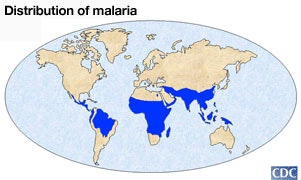Malaria Facts

We would like to acknowledge and thank the Centers for Disease Control for allowing the use of the following information and links concerning mosquito-borne illness.
United States Malaria Facts:
- 1,337 cases of malaria, including 8 deaths, were reported for 2002 in the United States, even though malaria has been eradicated in this country since the early 1950's.
- Of the 1,337 malaria cases reported for 2002 in the United States, all but five were imported, i.e., acquired in malaria-endemic countries.
- Between 1957 and 2003, in the United States, 63 outbreaks of locally transmitted mosquito-borne malaria have occurred; in such outbreaks, local mosquitoes become infected by biting persons carrying malaria parasites (acquired in endemic areas) and then transmit malaria to local residents.
- Of the ten species of Anopheles mosquitoes found in the United States, the two species that were responsible for malaria transmission prior to eradication (Anopheles quadrimaculatus in the east and An. freeborni in the west) are still widely prevalent; thus there is a constant risk that malaria could be reintroduced in the United States.
- During 1963-1999, 93 cases of transfusion-transmitted malaria were reported in the United States; approximately two thirds of these cases could have been prevented if the implicated donors had been deferred according to established guidelines.
Worldwide Malaria Facts:
- Forty-one percent of the world's population live in areas where malaria is transmitted (e.g., parts of Africa, Asia, the Middle East, Central & South America, Hispaniola, and Oceania).
- An estimated 700,000-2.7 million persons die of malaria each year, 75% of them African children.
- In areas of Africa with high malaria transmission, an estimated 990,000 people died of malaria. In 1995 over 2700 deaths per day, or 2 deaths per minute.
- In 2002, malaria was the fourth cause of death in children in developing countries, after perinatal conditions (conditions occurring around the time of birth), lower respiratory infections (pneumonias), and diarrheal diseases. Malaria caused 10.7% of all children's deaths in developing countries.
- In Malawi in 2001, malaria accounted for 22% of all hospital admissions, 26% of all outpatient visits, and 28% of all hospital deaths. Not all people go to hospitals when sick or having a baby, and many die at home. Thus the true numbers of death and disease caused by malaria are likely much higher.
Biology, Pathology, Epidemiology:
- Residents of Asembo Bay (Western Kenya) were bitten 60-300 times a year by a malaria-carrying mosquito in the 1990's, before control measures (including the use of insecticide-treated bed nets) were put in place.
- Among the four malaria species that infect humans, Plasmodium vivax and P. ovale can develop dormant liver stages that can reactivate after symptomless intervals of up to 2 (P. vivax) to 4 years (P. ovale).
- 84% of the blood transfusions given in March-June 2000 in a major hospital in Kinshasa (Democratic Republic of Congo) were for anemia caused by malaria.
- Pregnant women have increased susceptibility to Plasmodium falciparum malaria; in malaria-endemic countries, P. falciparum contributes to 8-14% of low birth weight, which in turn decreases the chance of a baby's survival.
- After a single sporozoite (the parasite form inoculated by the female mosquito) of Plasmodium falciparum invades a liver cell, the parasite grows in 6 days and produces 30,000-40,000 daughter cells (merozoites) which are released into the blood when the liver cell ruptures. In the blood, after a single merozoite invades a red blood cell, the parasite grows in 48 hours and produces 8-24 daughter cells, which are released into the blood when the red blood cell ruptures.
Prevention & Treatment:
- Four Nobel prizes have been awarded for work associated with malaria, to Sir Ronald Ross (1902), Charles Louis Alphonse Laveran (1907), Julius Wagner-Jauregg (1927) and Paul Hermann Muller (1948).
- Two important currently used antimalarial drugs are derived from plants whose medicinal values had been noted for centuries: artemisinin from the Qinghao plant (Artemisia annua L, China, 4th century) and quinine from the cinchona tree (South America, 17th century).
- Insecticide-treated bed nets decreased the mortality of children aged 1-11 months in a trial in western Kenya in 1997-1999.
- A survey in Southeast Asia in 1999-2000 showed that of 104 shop-bought samples purportedly containing the antimalarial drug artesunate, 38% contained no artesunate.
- The average cost for potentially life-saving treatments of malaria are estimated to be US$0.13 for chloroquine, US$0.14 for sulfadoxine-pyrimethamine, and US$2.68 for a 7-day course of quinine.
- Content source: National Center for Infectious Diseases, Division of Parasitic Diseases, Date: May 4, 2004
For additional information click here
